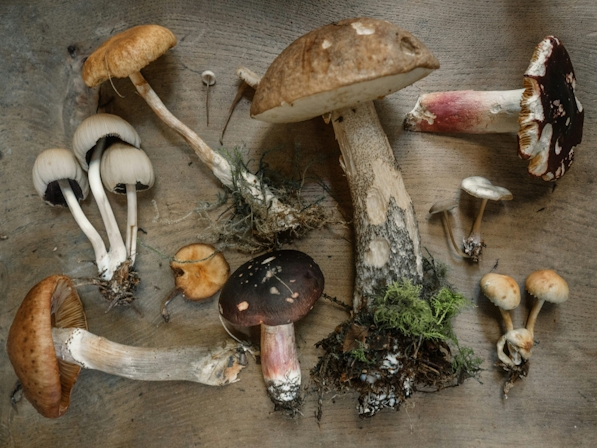
Photo by Jannik Selz
Mushroom Foraging: Guide To Harvesting Nature’s Hidden Gems
Harvesting sustainable, wild food sources from the earth’s pantry.
Mushroom foraging transforms a simple stroll through the forest into an exciting quest for nature’s hidden treasures.
In a world increasingly captivated by the convenience of mushroom supplements, sourcing mushrooms directly from their natural habitat offers a more hands-on, traditional way of interacting with nature. But before one charges straight to their closest conservation area, it’s important to understand what to look for and what to avoid.
This guide is a starter map for anyone ready to explore the art of foraging for mushrooms, touching on how to identify, collect and enjoy these wild offerings.
How To Start Foraging For Mushrooms

Photo by Nancy Newton
Knowledge Is Power
It’s wise to get familiar with mushroom anatomy before you begin foraging. This helps you distinguish between edible mushroom types and their toxic lookalikes.
Focus on identifying the cap, spore-bearing surfaces (gills, pores, spines), stem, and veil. Also, familiarizing yourself with local mushroom varieties can be helpful.
Dive into reputable resources for guidance. Potential books include:
- Mushrooming Without Fear by Alexander Schwab
- The Complete Mushroom Hunter by Gary Lincoff
- All That the Rain Promises and More: A Hip Pocket Guide to Western Mushrooms by David Arora
Works by mycologist Paul Stamets, such as Growing Gourmet and Medicinal Mushrooms, and Psilocybin Mushrooms of the World: An Identification Guide offer insights into fungi.
Assemble Foraging Gear
A successful forage requires the right tools in hand:
Basket or Mesh Bag: Ensures your fungal finds breathe, reducing spoilage during transport.
Pocket Knife: Vital for making clean cuts, ensuring the mycelium network below is undisturbed by forces like plucking.
Brush: Helps tidy up your treasures and wipe off any looming bugs.
Notebook or Smartphone: Ideal for documenting your discoveries.
Compass and Map: Essential for navigation, available in physical forms or on your phone.
Bug Spray, Water, Sunscreen, and Snacks: This keeps you safe, hydrated, protected from the sun, and energized during your foraging adventure.
Identifying Edible Mushrooms

Photo by Andrew Ridley
Edible mushrooms can be found in various environments, such as wooded areas like a forest, near trees, or even on decaying logs. Their habitats are as diverse as their appearances, with each species flourishing under specific conditions.
Here’s a guide to spotting some of the most common mushrooms sought after and where to find them:
Chanterelle Mushrooms

Photo by Forager Chef
These treasures contain a golden-yellow hue, wavy cap edges, and a delightful fruity aroma similar to apricots. Look for vase-shaped caps and false gills (ridges), along with looking under the forest’s canopy.
Morel Mushrooms

Photo by Mother Earth News
Known for their distinctive honeycomb-like caps, Morel mushrooms are adored by gourmet chefs for their earthy taste. Search wooded areas for their sponge-like caps, pitted surfaces and hollow stems.
Porcini Mushrooms

Photo by The Spruce Eats
These robust fungi feature a thick stem, a brown cap with white pores that may bruise yellow, with a rich nutty flavor. Look near the base of trees for these solid, brown-capped delights, with white pores that bruise yellow when touched.
Lion's Mane Mushrooms

Photo by Mycelium Society
With white cascading spines that resemble a lion’s mane, these mushrooms offer a taste and texture similar to seafood. They dangle majestically from hardwood trees, like oak or beech, waiting for the discerning eye of a mushroom hunter.
Oyster Mushrooms

These mushrooms charm with fan-shaped caps, delicate texture, and mild taste, often growing in clusters. Dead or dying hardwood trees are their preferred stage, showcasing their elegant caps in shades of white to gray.
Technology like the Mush and Mushroom Identify apps offer a modern aid in mushroom identification. They are best used to supplement your knowledge; no app can substitute the keen eye of an experienced forager or the wisdom contained within the pages of a mycologist’s guidebook.
Simply put, be cautious on your foraging journey, especially if you plan to consume your finds. If you are unsure which species you have collected, it is best not to consume until verified by an expert.
When To Forage?
Mushroom foraging peaks after rainfall, especially from late September to early November. During this period, the forest floor flourishes with rapidly sprouting mushrooms.
The foraging calendar can vary depending on the species you are seeking. Morels favor spring’s warm, while chanterelles have distinct seasons across different coasts, thriving from May to October in the East, and September to February in the West.
Armed with knowledge on how to forage for mushrooms, you’ll find that the hunt is always in season somewhere!
Best Locations For Mushroom Foraging

Photo by Jordan Quinten
Where to find mushrooms largely depends on their environment. Knowing where to look can transform your foraging adventure from a wild goose chase into a fruitful harvest.
Here are some top-notch locations and their habitats to keep on your radar:
Forests: The classic go-to for mushroom enthusiasts. Decomposing wood and rich soil create a haven for fungi. Scout around Beech, Oak, Birch, and Pine trees for the best finds.
Pastures: Grazing lands can be hidden gems for finding edible mushrooms. Always be mindful of machinery and animals in the vicinity; remember, trespassing is a no-go!
Parks: A more urban foraging ground, parks can yield a variety of mushrooms. Just be sure to check local regulations—some places might require a permit or have collection limits.
Mossy Areas: You can find moisture-loving mushrooms around moss-covered spots. These lush, green carpets signal a potentially rich mushroom-picking site, perfect for chanterelles and morels.
Near Water Bodies: Rivers, streams, and creeks create a microclimate ideal for certain species, like oyster mushrooms.
Preparing Your Foraged Mushrooms

Photo by Spice Cravings
Proper preparation is key to enjoying foraged mushrooms’ full culinary and nutritional benefits.
Start by gently cleaning, trimming off the dirty base and using a brush or cloth to remove visible dirt. Inspect for insects, removing any compromised sections. Pat dry to avoid any sogginess.
Store your mushrooms in an open paper bag or cardboard box in the fridge to let them breathe and prevent moisture buildup, ensuring they stay fresh for up to 1-2 weeks, depending on quality and storage conditions. Always check for signs of spoilage before cooking with mushrooms.
When it’s time to cook, the possibilities are endless. Sauté, roast, or grill them to highlight their flavors. Incorporate them into soups, stews, pasta, or risotto for a delicious twist.
Wild mushrooms are not just a gourmet delight; they’re also packed with nutritional benefits. Rich in vitamins, minerals, and antioxidants, they contribute to a healthy diet by boosting the immune system, reducing inflammation, and supporting heart health.
Herb Recommended Products:
READ MORE










